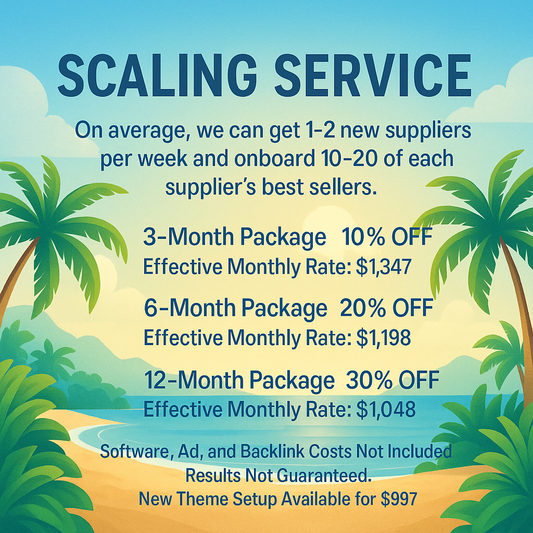
Boost Your High-Ticket Business with Analytics
Hello fellow entrepreneurs! Trevor Fenner here, and today we’re diving into an essential topic for anyone running a high-ticket dropshipping store: using analytics to your advantage. Analytics can seem daunting, but when utilized effectively, it can skyrocket your business success. Let's explore how you can leverage data to enhance your eCommerce game—specifically for those in the done for you ecommerce niche.
Understanding the Importance of Analytics
When it comes to operating a high-ticket dropshipping store, understanding your data is crucial. Analytics provides insights into your customers, their behaviors, and your business performance. With this information, you can make informed decisions that will help you optimize your operations. Here’s why it matters:
- Customer Insights: Knowing who your customers are allows you to tailor your marketing strategies directly to them.
- Performance Measurement: By observing how your store performs over time, you can identify what works and what doesn’t.
- Forecasting Trends: Analytics helps you keep ahead of market trends—essential for maintaining a competitive edge in high-ticket sales.
Setting Up Your Analytics Tools
Before diving into data interpretation, you need the right tools in place. Numerous analytics platforms are available, but for a high-ticket dropshipping store running on Shopify, here are the essentials:
Google Analytics
Google Analytics is a must-have. It gives you insight into how visitors are interacting with your store. Here’s how to set it up:
- Sign up for a Google Analytics account.
- Link your Shopify store to Google Analytics through the data settings.
- Set up goals to track conversions specific to your high-ticket items.
Shopify Analytics
Your Shopify dashboard comes with built-in analytics. Use these features to track sales, customer behavior, and traffic sources:
- Sales Reports: Understand your best-selling items and times of the year.
- Customer Reports: Insights into demographic and geographic data regarding your customers.
Interpreting Your Analytics Data
Once your analytics tools are in place, it’s time to start interpreting the data. Here are key areas to focus on for your high-ticket dropshipping store:
Traffic Sources
Understanding where your traffic is coming from allows you to allocate your marketing budget effectively. Are visitors coming from organic search, social media, or paid ads? Focus your efforts on the channels that yield the highest return.
Customer Behavior
Look at metrics like bounce rate and time spent on site. A high bounce rate may indicate that visitors are dissatisfied with what they see. If users are spending a lot of time on your site, they may be interested in more information before committing to a high-ticket purchase. Use this to your advantage:
- Optimize your landing pages to be more engaging.
- Provide sufficient information to build trust in high-value offerings.
Using Data to Improve Your Store’s Conversion Rates
Conversion rates are vital for a high-ticket dropshipping store. Here are a few data-backed strategies to help improve them:
Refining Product Pages
Your product pages are the heart of your store. Use analytics to determine which pages are underperforming and experiment with elements to enhance engagement:
- High-Quality Images: Ensure your product images are high resolution and showcase the product from multiple angles.
- Detailed Descriptions: Provide thorough descriptions that discuss key features and address potential concerns of a high-ticket purchase.
Enhanced User Experience (UX)
Analytics offers an opportunity to improve overall UX based on user behavior. Monitor heat maps and user flow to identify customer journeys. Identify where users drop off, and make adjustments to guide them toward checkout.

Marketing Strategies Driven by Data
As a high-ticket dropshipping store owner, the way you market your products will greatly affect your success. Utilize analytics to fine-tune your marketing strategies:
Retargeting Campaigns
Using analytics, you can identify customers who visited your store but didn’t convert. Retarget them with specific ads that emphasize the value of making that high-ticket purchase:
- Use Email Marketing: Send personalized follow-ups reminding them of the product they viewed.
- Social Media Ads: Create ads focused on the benefits of the products they expressed interest in.
Content Marketing
Creating high-quality, informative content is essential for high-ticket items. Use analytics to see what topics resonate with your audience. This can help position you as a trusted authority in your niche. Here’s how you can leverage it:
- Blog Posts: Write articles that discuss industry trends or product benefits.
- Video Content: Offer tutorials or product demos that showcase their value.
Regularly Reviewing Your Analytics
Analytics isn’t a one-time task; it’s ongoing. Make it a habit to review your analytics regularly:
- Monthly Reviews: Analyze your data on a monthly basis to identify trends over time.
- Quarterly Adjustments: Make more substantial changes based on quarterly reviews of performance and strategy.
The Value of A/B Testing
In the quest to improve your high-ticket dropshipping store, A/B testing is a powerful tool. By testing variations of your online store, you can identify the elements that resonate best with your audience. Important aspects to consider testing include:
- Call-to-Action Buttons: Experiment with different wording and colors.
- Pricing Strategies: If possible, test different price points to find the sweet spot that maximizes sales.
Measuring the Impact of A/B Testing
Keep track of your A/B tests via your analytics tools. Analyze results to understand which variations lead to higher conversion rates, and confidently adopt the winners in your strategy.
Staying Ahead of Competitors
The eCommerce space can be competitive, especially in high-ticket items. Leveraging your analytics provides a crucial edge. Here’s how to stay one step ahead:
- Market Analysis: Use analytics to identify your competitors' strengths and weaknesses.
- Targeted Marketing: Cater your marketing strategies based on your findings; focus on areas competitors may be neglecting.
Gaining Customer Loyalty through Data
Analytics can also enhance customer loyalty, which is particularly valuable for high-ticket items. By understanding your customers' behavior, you can foster lasting relationships that increase repeat purchases:
Personalized Experiences
Utilize customer data to create personalized experiences. From personalized email recommendations to loyalty programs based on their shopping habits, connecting with your customers can yield significant long-term benefits.
Collecting Feedback
Through surveys or product reviews, gather feedback about your customers' experiences to refine your offerings continually. Analytics can help track this feedback effectively and implement changes that positively impact customer satisfaction.
Final Thoughts: Your Roadmap to Success
Native to the path of entrepreneurship in the high-ticket dropshipping world, using analytics effectively can set you apart from the rest. Remember, analytics isn’t just about numbers. It’s about understanding your customers, improving your offerings, and enhancing your marketing strategies. By building a solid foundation with analytics, you position your done for you ecommerce store for scalable growth. Stay curious, keep experimenting, and let data drive your decisions. Here’s to your thriving high-ticket dropshipping journey!


















